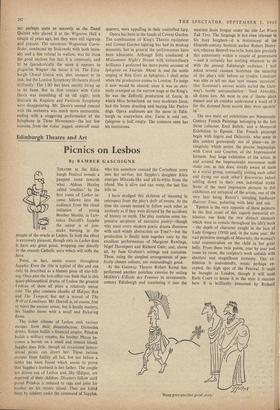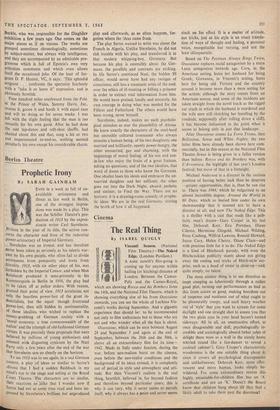Edinburgh Theatre and Art
Picnics on Lesbos
By BAMBER GASCOIGNE THEATRE at the Edin- burgh Festival reveals a pungent trend towards what Aldous Huxley called `smellies.' In the first scene of Luther in- cense billows into the audience from the ritual Point, in fact, seems scarce throughout Sappho. Even the title is typical of this and can only be described as a blatant piece of star-bill- ing. Once past the box-office one finds that in this quasi-philosophical drama of Lesbos the greatest Lesbian of them all plays a relatively minor role. The play contains chunks of tEdipus Rex and The Tempest, but not a morsel of The Well of Loneliness.. Mr. Durrell is, of course, free to reject the ancient smear, but it hardly matters; his Sappho burns with a small and flickering flame.
The richer citizens of Lesbos seek various escapes from their dissatisfaction. Diomedes drinks, Kreon builds a financial empire, Pittakos builds a military empire, his brother Phaon be- comes a hermit on a small and remote island. Sappho does little, though an occasional hetero- sexual picnic can divert her. These various escapes from futility all fail, but not before a tablet has been found which seems to prove that Sappho's husband is her father. The couple are driven out of Lesbos and, like CEdipus, are deprived of their children. Disasters follow until proud Pittakos is reduced to rags and joins his brother on his mystic island. They are killed there by soldiers under the command of Sappho, who has somehow coerced the Corinthian army into her service; but Sappho's daughter Kleis emerges Miranda-like and all-in-white from the island. She is alive and can weep, the last line tells us.
I have dredged this skeleton of meaning in retrospect from the play's drift of events. At the time the scenes seemed to follow each other as aimlessly as if they were dictated by the accidents of history or myth. The play contains some im- pressive set-pieces of narrative poetry—though why must every modern poetic drama discourse with such windy abstraction on Time?—but the production is finally held together only by the excellent performances of Margaret Rawlings, Nigel Davenport and Richard Gale; and, above all, by Jane Graham's settings and costumes. These, using the simplest arrangements of per- fectly chosen colours, are outstandingly good.
At the Gateway Theatre Robert Kemp has performed another pointless exercise by setting Molibre's L'Ecole des Femmes in seventeenth- century Edinburgh and translating it into the meatiest Scots brogue under the title Let Wives Tak Tent. The language is not even relevant to his busy burghers—it is reminiscent of the fifteenth-century Scottish author Robert Henry- son, whereas Boswell was to be born into precisely this community within a couple of generations —and it certainly has nothing whatever to do with the present Edinburgh audience. I had asked several random Scotsmen the meaning of the play's title before an erudite Londoner was able to tell me that 'tent' means 'attention.' One Scotsman's answer neatly nailed the Gate- way's feeble antiquarianism: 'God Almichty, ah dinna ken. Ah went to one o' thame plays maseel and ah couldna understand a word of it for the damned Scots accent they were speakin' in.'
The two main art exhibitions are Nineteenth- Century French Paintings belonging to the late Swiss collector, Emil Bilhrle, and a Memorial Exhibition to Epstein. The French paintings begin with Ingres and Delacroix, who seem in this context grotesquely out of place—an in- congruity which points the precise beginnings, with Corot and Courbet, of the Impressionist ferment. Any large exhibition of the artists in and around the Impressionist movement must make one, as this does, vividly aware of them as a social group, constantly visiting each other and trying out each other's discoveries before settling down to their own individual styles. Some of the most impressive pictures in this exhibition are untypical of the artists; one of the very best being Renoir's amazing landscape Harvest Time, pulsating with heat and sun.
Epstein is the very opposite of these painters. In the first room of this superb memorial ex- hibition one finds the two distinct elements which were to remain throughout his life's Work —the depth of character caught in the bust of Lady Gregory (1910) and, in the same year, the vast primitive strength of Maternity, the woman's total concentration on the child in her great belly. From these twin points, year by year and room by room, the sculptor's work unfolds with absolute and magnificent certainty. This ex- hibition is undoubtedly, music perhaps ex- cepted, the high spot of the Festival. It must be brought to London, though it will need Earls Court to house it in the style it receives here. It is brilliantly presented by Richard 'Bang goes another good story.' Buckle, who was responsible for the Diaghilev exhibition a few years ago. One comes on the major pieces as if on visions. The works are grouped sometimes chronologically, sometimes by subject-matter, but always with intelligence; and they are accompanied by an admirable pro- gramme which is full of Epstein's own very articulate comments and which even allows itself the occasional joke. Of the bust of Ser- geant D. F. Hunter, VC, it says: `This splendid sergeant . . . confronts the spectator fearlessly With a "take it or leave it" expression, and is obviously Scottish.'
Four hundred miles southward from the Pole. at the Prince of Wales, Sammy Davis, Jnr., croons it, goons it and hoofs it with equal ease and will be doing so for seven weeks. I was left with the slight feeling that the man is too versatile for his own good. After he had done the odd tap-dance and soft-shoe shuffle, had chatted about this and that, sung a hit or two and impersonated so-and-so, nothing seemed Peculiarly his own except his considerable charm.



































 Previous page
Previous page